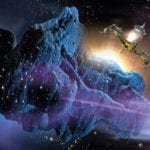 Music
Music  Music
Music  History
History 10 Less Than Jolly Events That Occurred on December 25
 Weird Stuff
Weird Stuff 10 Funny Ways That Researchers Overthink Christmas
 Politics
Politics 10 Political Scandals That Sent Crowds Into the Streets
 Weird Stuff
Weird Stuff Ten Bizarre Facts About The Doge Meme
 Our World
Our World 10 Ways Your Christmas Tree Is More Lit Than You Think
 Movies and TV
Movies and TV The 10 Coolest Stars to Set Sail on The Love Boat
 History
History 10 Things You Didn’t Know About the American National Anthem
 Technology
Technology Top 10 Everyday Tech Buzzwords That Hide a Darker Past
 Humans
Humans 10 Everyday Human Behaviors That Are Actually Survival Instincts
 Music
Music 10 Surprising Origin Stories of Your Favorite Holiday Songs
 History
History 10 Less Than Jolly Events That Occurred on December 25
 Weird Stuff
Weird Stuff 10 Funny Ways That Researchers Overthink Christmas
Who's Behind Listverse?

Jamie Frater
Head Editor
Jamie founded Listverse due to an insatiable desire to share fascinating, obscure, and bizarre facts. He has been a guest speaker on numerous national radio and television stations and is a five time published author.
More About Us Politics
Politics 10 Political Scandals That Sent Crowds Into the Streets
 Weird Stuff
Weird Stuff Ten Bizarre Facts About The Doge Meme
 Our World
Our World 10 Ways Your Christmas Tree Is More Lit Than You Think
 Movies and TV
Movies and TV The 10 Coolest Stars to Set Sail on The Love Boat
 History
History 10 Things You Didn’t Know About the American National Anthem
 Technology
Technology Top 10 Everyday Tech Buzzwords That Hide a Darker Past
 Humans
Humans 10 Everyday Human Behaviors That Are Actually Survival Instincts
10 Things You Never Knew Survived the Chicxulub Asteroid
This space rock punched Earth roughly 66 million years ago and caused the Cretaceous-Paleogene mass extinction—otherwise known as the K-Pg event. The latter famously killed off the non-avian dinosaurs and 75% of all other species. However, not everything perished. From your morning cup of coffee to non-avian dinosaurs that actually flourished for thousands of years, here are ten remarkable Chicxulub survivors.
Related: 10 Weird Critters That Lived Alongside the Dinosaurs
10 Cockroaches
This one is no surprise. These goobers are legendary for resisting every attempt to eradicate them. Even so, this is a challenging survival story. When the asteroid struck, roaches faced a hellish environment of mega earthquakes and floods, volcanic eruptions, and more. By the time the dust settled, three-quarters of all plant and animal species were gone forever.
Roaches were among the lucky few to survive both the strike and the fallout. As it turns out, they were well-equipped for the situation. While some cockroaches undoubtedly roasted in the impact’s immediate aftermath, their small, flat bodies allowed many more to safely hide in tiny crevices, which shielded them from the heat.
The rock threw up so much dust that the sky dimmed and triggered a long winter. More plants died, and the struggling survivors that depended on them starved. Not cockroaches. As scavengers that eat anything, they had plenty of food. Additionally, roach eggs are extremely tough and likely protected the next generation in the harsh times that followed.[1]
9 Roses
The roses we see today are not the same that bloomed in prehistory. But the plant family they belong to, Roaceae, were among countless angiosperms (flowering plants) that grew on Earth millions of years before the K-Pg event. Indeed, the world before the asteroid was a flowery paradise.
After the impact, things just got better for flowers. It is believed that angiosperm development exploded as a direct result of the disaster and led to the evolution of today’s roughly 290,000 flowering species.
The survival of these plants is a mystery. Unlike dinosaurs, angiosperms are fragile and cannot defend themselves or run away from a dangerous situation. Even the sunlight that they needed to survive was blocked for years following the impact. Yet, strangely, the dinosaurs perished, and flowers thrived.[2]
8 Snakes
When dinosaurs walked the earth, they never had to sidestep vipers and cobras. Boas and pythons didn’t strangle anything, nor did tree and sea snakes bite a single creature. How so? These snakes didn’t exist.
Before the K-Pg mass extinction event, snakes slithered about, but they were different. Most notably, the shape of their vertebrae was distinct and unique, and this ancient design is no longer present in modern snakes. The fossil record showed that these Cretaceous creatures were hit hard, quite literally, when the asteroid struck. Only a handful survived.
But they were a fruitful bunch. Despite the environmental challenges that followed the disaster, these primitive snakes flourished and filled almost every ecological niche, becoming the ancestors of over 3,000 snake species today.[3]
7 Deep Sea Creatures
The K-Pg event left many questions. One of the most enduring mysteries was this—how did deep sea organisms survive the cataclysm? Indeed, living in the ocean offered no protection against the effects of the asteroid, and the die-off was catastrophic. About 60% of all life in the sea perished, and countless species went extinct.
Yet, despite the acid rain that fell on the oceans, the dust that blocked sunlight, and the collapse of a critical food chain that once served seafloor critters, the latter endured. In 2016, researchers realized that wasn’t the real picture. They found strong evidence that certain types of bacteria and algae, essential ingredients in the “lost” food chain, had survived the terrible conditions.
These bacteria and algae lived in the upper layers of the ocean, but they often sank to the seafloor. This provided deep sea creatures with a constant trickle of food that saw them through the disaster.[4]
6 Solenodon
Many people have never heard about or seen a solenodon. Once they do, they are rarely disappointed. Measuring 19 to 28 inches (49 to 72 cm), this small animal resembles a scruffy shrew with a trunk-like nose. The cute face hides a secret—the solenodon is venomous. Its saliva is so poisonous that one bite can kill a mouse in minutes.
In recent times, scientists analyzed the DNA of the Hispaniolan solenodon, a highly endangered inhabitant of Cuba and the island of Hispaniola where it has lived in isolation for millions of years. The research aimed to settle a debate: Did these critters evolve before or after the asteroid hit Earth?
The gene-gazing told an interesting story. It proved that solenodons split from other mammals 73.6 million years ago—long before the ancient disaster. As a bonus, the genetic study also discovered that the Hispaniolan solenodon was actually two animals, having split from itself and created a subspecies about 300,000 years ago.[5]
5 Honeybees
When bees were found in dinosaur-era amber, researchers discovered that the ancient insects were almost identical to modern honeybees. This strongly suggested that one was the direct ancestor of the other. While this probably put honeybees on the asteroid survivor list, this familial link spawned a controversial mystery.
The problem is this. Tropical honeybees need temperatures in the range of 88 to 93 Fahrenheit (31 to 34°C) to live. Current research suggests that the prolonged winter that followed the impact should have wiped out any bees lucky enough to have escaped the asteroid’s initial devastation.
The fact that bees are buzzing around today proves that an unknown factor prevented their extinction. But why is the mystery so controversial? Since no bees could have survived the years of cold and dark, this suggests that something is wrong with the well-established K-Pg nuclear winter theory. [6]
4 Coffee
Had the asteroid obliterated a certain plant, espresso and cappuccino wouldn’t exist today. This plant would later evolve into coffee and other useful crops, including potatoes, tomatoes, and mint.
The fact that coffee nearly got wiped out before it was even coffee didn’t scare caffeine-loving scientists. Why? For a long time, researchers believed that the ancestor of coffee only evolved after the K-Pg event. They were wrong.
Brian Atkinson, a curator of paleobotany, recently found a fossil fruit at the Sierra College Museum of Natural History in California. The moment he saw it, he realized the magnitude of his discovery. It was a Cretaceous lamiid or a coffee ancestor that once lived with the dinosaurs.
The new species, named Palaeophytocrene chicoensis, belonged to a known family of plants that were abundant after the cataclysm, but not a single specimen had even been found before the event—until now.
At 80 million years old, the fruit proved that the origins of lamiids were not a post-asteroid thing. Instead, they appeared roughly 20 million years before the stellar smash. Today, lamiids have evolved into thousands of species.[7]
3 Sharks
The prize for dodging the most mass extinctions goes to sharks. During their 400-million-year existence, sharks have survived five catastrophic extinction events. The last was the K-Pg event.
When scientists wanted to understand how badly the asteroid had affected elasmobranch species—which includes sharks, rays, and skates—the study looked at fossils from all over the world. Eventually, they narrowed things down to 675 specimens of sharks and their kin that lived around the time of the impact.
The fossils painted a brutal picture. Around 62% of all elasmobranch species were wiped out. Among them, 59% of shark species went extinct, and rays were hit even worse, losing as many as 72% of their diversity.
Interestingly, the fossils showed that ancient shark species were less likely to survive the K-Pg event and its aftermath. Younger shark species, especially those that lived in the open ocean and had large territories, were more likely to live on.[8]
2 Dog and Human Ancestors
All living mammals today are placentals, or animals that develop a placenta during pregnancy. The only mammals excluded from this club are marsupials (like kangaroos) and monotremes (one example is the platypus) because they don’t grow placentas.
Right before the K-Pg event, several major placental mammal groups evolved. These included primates, Lagomorpha, and Carnivora. Respectively, they were the ancestors of modern humans, rabbits, and dogs. For a short time, they walked with dinosaurs, but then the asteroid arrived and killed off the dinosaurs but not the placental mammals.
With so many ecological niches left empty by the dinosaurs, the mammals diversified rapidly to fill them. They began to evolve into all the modern lineages of placentals. This leaves a scary thought. Had the asteroid wiped out the placentals or failed to pave the way for their evolution, humans might never have existed.[9]
1 Non-Avian Dinosaurs
Most articles or books about the K-Pg event state that the asteroid wiped out all the non-avian dinosaurs. However, contrary to popular belief, the dinosaur age did not end with the deadly impact. One population of animals managed to survive afterward for a mind-boggling amount of time.
In recent times, a fossilized leg bone was found in New Mexico, and it belonged to a hadrosaur. Also called duck-billed dinosaurs for their flat, toothless snouts, they walked upright on powerful back legs and consumed plant matter.
When the bone was tested, a remarkable lost piece of history was rediscovered. This hadrosaur had died 700,000 years after the asteroid impact. This means that enough hadrosaurs had survived the mass extinction to continue as a species and that Earth still had dinosaurs for the better part of a million years after they supposedly all went extinct.[10]








